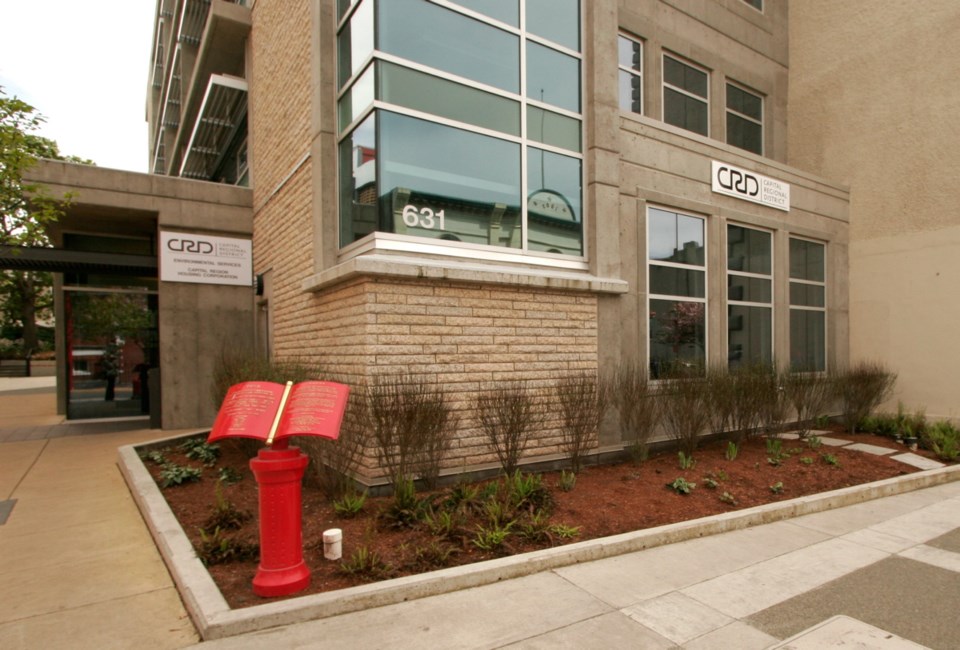Capital Regional District operational spending is projected to increase about $12.1 million to about $260.6 million in 2019 in what is being described as a status quo budget.
Taxpayers could see property tax increases ranging from less than one per cent to more than 15 per cent, depending on where they live and whether their municipality is part of the core area sewage treatment program.
The 2019 provisional financial plan also includes a $51.2-million increase in the CRD’s capital budget to $309.9 million — driven primarily by sewage treatment.
When the budgets of the Capital Regional Hospital District and the Capital Region Housing Corporation are factored in, CRD operating costs are $309 million and capital costs are $381 million.
Victoria Coun. Ben Isitt argued consideration of the financial plan should be delayed until after the Oct. 20 municipal election, so that newly elected CRD directors have a voice.
Isitt noted that none of Greater Victoria’s municipalities are beginning budget deliberations until new councils are in place, and that CRD budget deliberations didn’t begin last year until Nov. 29. “I think it’s fair to the incoming directors and the electorate they represent to not, sort of, have prior decision-making for them,” Isitt said.
CRD staff said the new board will have the opportunity to review and reconsider the budget.
CRD executive director Bob Lapham said that as local governments operate on a five-year financial plan, the current financial plan “reflects commitments made by the board up to this point and completes a number of priorities that the board has put in motion.”
“It’s really critical that the organization … get direction from the board at this time to take us through that election cycle,” Lapham said.
Victoria Mayor Lisa Helps noted that the CRD’s finance committee and board both approved the budget process in May.
“I’m completely comfortable, whether or not I’m here at this table again, that the new directors will get the exact same package that we got today and that they’ll be able to inform the decisions for 2019 and the next four years with their priorities,” she said.
Of the $12.1 million in new revenue the CRD says it needs, $8.1 million is expected to come from additional fees and charges, while about $3.4 million is projected to come from an overall increase in property taxes of 5.4 per cent.
The percentage property tax increase homeowners will see will vary depending on what CRD services their municipality or electoral district participates in.
It’s the sewage treatment project, now under construction, that is the major driver behind the tax increases, say CRD staff.
Homeowners in Colwood, Esquimalt, Langford and View Royal — municipalities funding their share of the $765-million core area sewage treatment program through property taxes — will see property tax increases of 12.35 per cent, 15.23 per cent, 12.32 per cent and 10.38 per cent respectively.
In Saanich, Victoria and Oak Bay, where sewage treatment is funded through utility charges, tax increases for CRD services are 3.86 per cent, 3.61 per cent and 1.32 per cent respectively.
Other municipalities and electoral areas are not affected by the core area sewage treatment program.
CRD capital projects are typically funded through annual contributions from operations, grants, reserves or by long-term debt.
Anticipated major capital spending includes:
• $243 million for the sewage- treatment program.
• $28 million for regional, Juan de Fuca and Saanich Peninsula water supply improvements.
• $9 million in additional sewage infrastructure.
• $11 million in park infrastructure including phases three and four of the E&N Rail Trail, Elk/Beaver Lake washrooms, and Todd Creek Trestle upgrades.
• $5 million in landfill projects.



